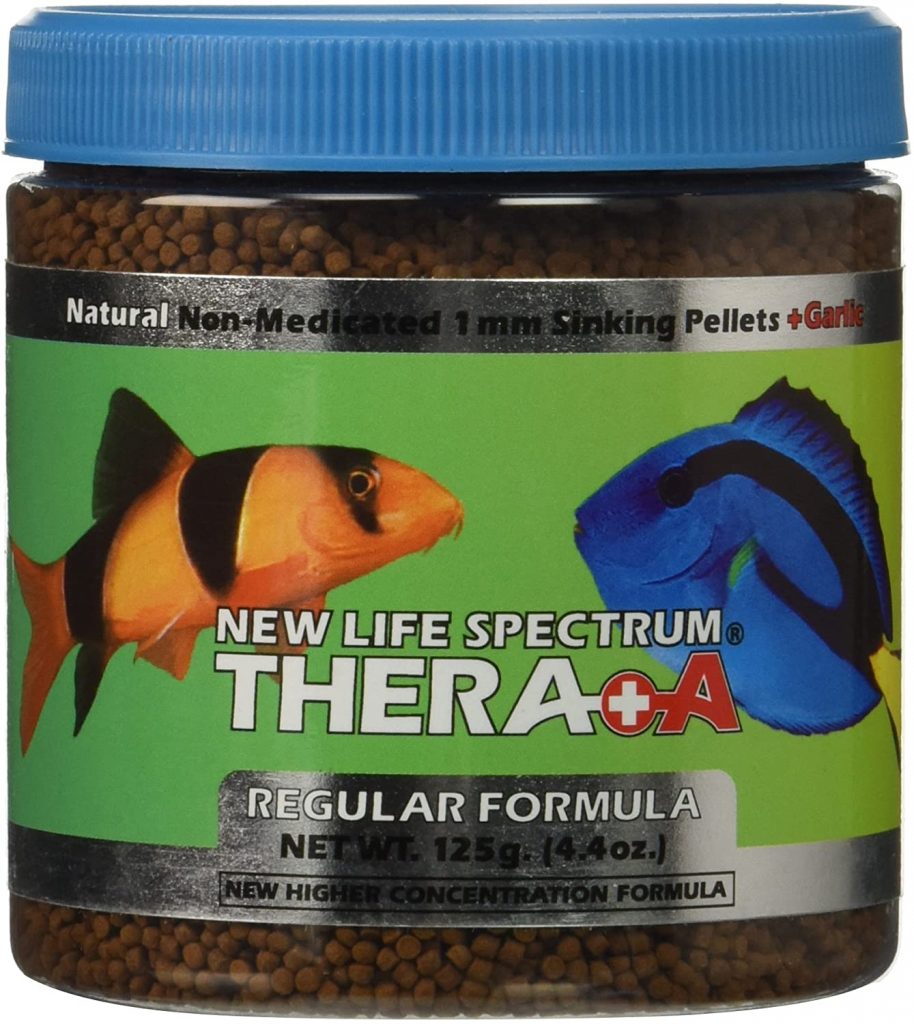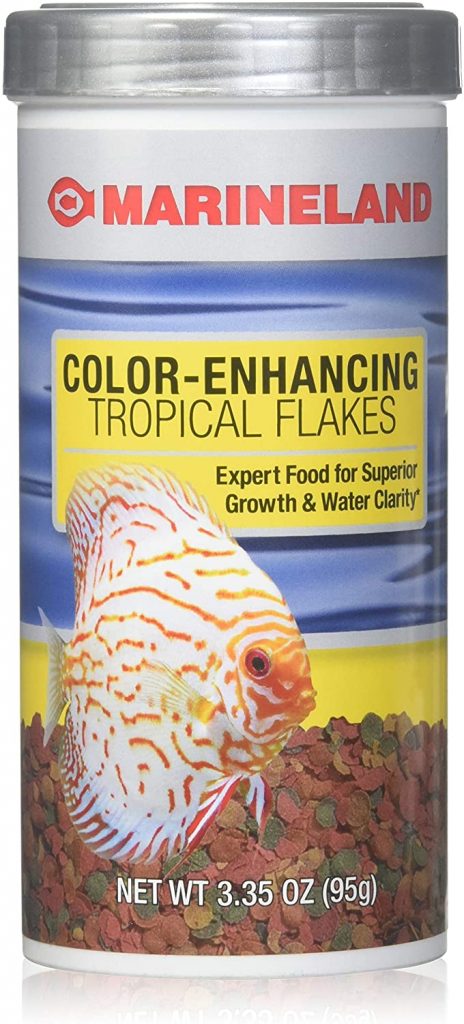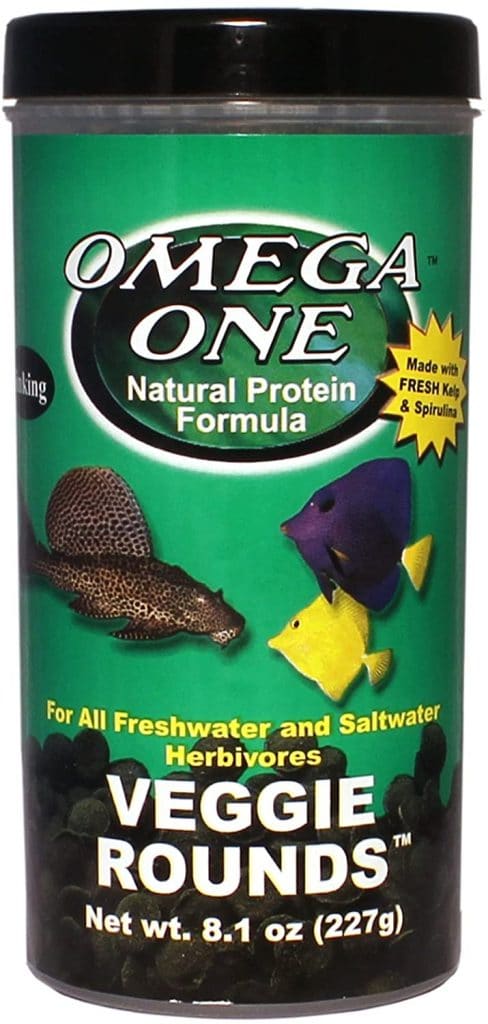Contents
- Types of Fish Food
- A List of 15 Best Fish Food to Choose From
- 1. New Life Spectrum Thera+A
- 2. TetraMin Tropical Flakes Fish Food
- 3. Aquarian Complete Nutrition
- 4. Aqueon Tropical Flakes Freshwater Fish Food
- 5. Marineland Color-Enhancing Tropical Flakes Fish Food
- 6. Seachem NutriDiet Marine Fish Flakes
- 7. Tetra Holiday Menu Tropical and Temperate Fish Food
- 8.120 Tab Tetra Plecomin Fish Food
- 9. Omega One Cichlid Flakes Fish Food
- 10. Omega One Betta Buffet Pellets
- 11. Hikari Bio-Pure Freeze-Dried Bloodworms
- 12. Omega One Veggie Rounds
- 13. Omega One Shrimp Pellets
- 14. New Life Spectrum’s Marine Fish Formula
- 15. Hikari Algae Wafers
- Why Should You NOT Overfeeding Your Fish?
- Wrapping Up!
Aquarium fish are a special pet as they inhabit a self-contained environment, and you cannot interact with them directly. Having said that, owning a home aquarium brings in a range of enormous benefits over other pets.
Keeping a home aquarium has been proved to lower stress and reduce blood pressure, and you’ll have a certain sense of satisfaction from creating, designing, and maintaining a thriving aquatic ecosystem in your space.
Like any pet, aquarium fish need a balanced diet to grow. What most people do not know is that different species have different nutritional needs. Our post today will help you find out the best fish food that will offer beneficial vitamins and minerals to your beloved pets.
Types of Fish Food
Before identifying the best food for your fish, let’s figure out how many types of fish food are available to choose from.
Flakes
Fakes are great for feeding mid-water and surface-feeding fish. Fish flakes are often made from dehydrated ground ingredients, which are spread paper-thin and baked. Since the flakes will be soaked, they drop to the bottom, where fish living in that area can eat them.
Pellets
Pellets are tiny sticks or balls of dehydrated fish food. Pettlets can have various sizes to fit different fish species and can be floating or sinking.
Sinking wafers
Wafers are disks of fry food that are produced to sink to the bottom. This type of food is suitable for catfish, plecos, and other bottom-dwellers. Wafers are often regarded as “algae” waters; however, they often don’t include much algae and are generally of poor quality.
Gel food
Gel can come in a powder that you can combine with hot water to make a stiff jelly-like substance. You can also buy pre-made gel in small plastic tubes that you just need to squeeze into the aquarium. Gels are quite expensive, but your fish will love them as a treat.
Free-dried food
Freeze-dried food often contains bloodworms, brine shrimp, and so on. This food is a good source of meaty protein.
Frozen food
Frozen food are daphnia, brine shrimp, bloodworms, mosquito larvae, etc., that are flash-frozen into cubes.
Live food
Live food, including brine shrimp, daphnia, and bloodworms, are loved by fish, particularly predatory species which are natural-born hunters. Besides, you can buy “feeder fish” like goldfish, guppies, or minnows to feed larger predatory species.
However, the downside of live food is that it might come with unexpected extras such as bacteria and parasites that could be harmful to your fish.
A List of 15 Best Fish Food to Choose From
1. New Life Spectrum Thera+A

New Life Spectrum Thera+A contains high-quality ingredients to feed a number of saltwater and freshwater fish.
A lot of beginner aquarium hobbyists make the mistake of thinking that all fish food is manufactured equal. Different species of fish have various nutrition requirements, and different types of fish food have various benefits. New Life Spectrum Thera+A is a high-quality fish food that satisfies the nutritional requirements of a broad range of freshwater and saltwater fish.
This formula mixes the brand’s high-density Spectrum Nutrition Formula with various nutrients and healthy oils to feed freshwater and saltwater fish. Including quality ingredients such as whole fish, whole Antarctic krill, spirulina, and garlic, the recipe is nutritionally balanced and built to improve the health, color, and condition of aquarium fish. Additionally, it is easy to absorb and comes in multiple pellet sizes.
2. TetraMin Tropical Flakes Fish Food

TetraMin Tropical Flakes are freshwater flakes produced with yeast, fish meat, and brown rice.
They are easy to absorb and won’t discolor the water, so you don’t need to raise your water cleaning regimen. They have high levels of protein and fat, and a various selection of minerals and vitamins to prevent disease and keep your fish healthy. Plus, there is a certain amount of Omega-3 to maintain a healthy immune system.
These tropical flakes have a high acceptance rate with fish, so you don’t need to worry about getting your tropical stock to eat them. However, this food is quite pricey; you need to pay a little more to feed your fish.
3. Aquarian Complete Nutrition

These flakes are designed for fish that inhabit a tropical aquarium or for temperate fish such as barbs, guppies, angelfish, and tetras.
They are nutrient-sufficient, making sure your fish can remain active and healthy. Tropical fish flakes consist of more meaty ingredients and protein to help them regular their temperature.
4. Aqueon Tropical Flakes Freshwater Fish Food

Aqueon’s tropical flakes are made for freshwater fish. They combine whole fish meal, including herring and salmon, and do not have any artificial colorings. Some manufactures add artificial colors to help improve the color of the flake. However, this can result in water clouding and make your fish produce more waste.
This fish food has a varied and balanced list of ingredients. Hence, the fish can digest most of the ingredients and produce less waste, lowering the requirement for cleaning.
5. Marineland Color-Enhancing Tropical Flakes Fish Food

The fish food from Marineland has a lot of carotenoids that can improve colors on the orange to red spectrum. Besides, it includes a rich source of protein (anchovies) that is ideal for fostering the growth and strength of your fish stock.
You can use these flakes to feed any freshwater fish. They vary in different sizes, suitable for all types of fish in your aquarium. In addition, they use a low-heating preparation which helps keep the nutrients and dodges color from bleaching the water.
6. Seachem NutriDiet Marine Fish Flakes

Seachem NutriDiet Marine Fish Flakes are reasonably priced and are created with chlorella, vitamin C, probiotics, and garlic guard to provide all the essential nutrients and vitamins to your fish.
The food is formulated from high-quality and natural ingredients. It contains a high amount of GMO. GMO ingredients are regarded as a source of some vitamins for fish and used to replace natural ingredients such as plankton. This can help cut manufacturing costs down but appears less appealing to the fish.
7. Tetra Holiday Menu Tropical and Temperate Fish Food

Fish can be kept in a kennel or cattery, so if you plan to go on a holiday and there won’t be anyone to feed them, it is important to get something for them to eat.
You can use these sticks to feed your fish for up to 14 days. The feeding block is based on a gel formula instead of a gypsum block. Therefore, it won’t make the water go cloudy or make the filter overwork.
Moreover, they also remain intact, as opposed to breaking down, so your fish won’t need to go scavenging near the bottom of the aquarium.
It is ideal for both temperate and tropical fish, and it is easy to change the dosage depending on how many fish you have and how big the aquarium is. You can add a maximum of three blocks to a big tank for 14 days.
8.120 Tab Tetra Plecomin Fish Food

These tablets are exclusively for herbivores, so they can be considered a single food source or extra bloodworm or meat supplements.
Tablets are made to drop to the bottom of the aquarium. They break down very slowly, making it perfect for both bottom feeders and timid fish.
9. Omega One Cichlid Flakes Fish Food

This fish food is made from fresh seafood combined with ocean kelp. It includes fresh salmon, krill, shrimp, halibut, and more. It has a high amount of Omega-3 and Omega-6 to ensure good health, high nutrition and enhance the color of your cichlid. The recipe is low in starches, which can prevent water discoloration and clouding.
The large rub proves great value for money; nevertheless, some users have complained that flakes range in size with a mixture of small flakes and clumps.
10. Omega One Betta Buffet Pellets

Packed with whole fish proteins and color-improving nutrients, Omega One Betta Buffet Pellets will ensure your betta fish look and feel better.
Also called Siamese Fighting Fish, better fish are some of the most brilliantly colored fish in the freshwater tank hobby. These fish are best raised in aquariums by themselves (at least for males of the species) and they need a nutrient-rich, carnivorous diet.
Formulated with fresh Alaskan seafood, this fish food provides unmatched nutrition for betta fish. These pellets are made to float on the surface of the aquarium where your beta can easily find them, although they may fall to the bottom as they take on water. Besides herring, salmon, and shrimp, these pellets consist of color-boosting nutrients to help betta fish have the best look.
According to Dr.Fox Magazine, this food has a whopping 42% crude protein and very little ash, so it is not likely to cloud or harm your tank water.
11. Hikari Bio-Pure Freeze-Dried Bloodworms

This product is freeze-dried to maintain nutritional quality, and they don’t have detrimental parasites or bacteria.
People might not think of aquarium fish as carnivorous, but most of the species are. Tetras, discus fish, and betta fish are all examples of fish requiring a carnivorous diet from meat-based food such as worms and other insects. One of the most popular fish food picks for carnivores is Hikari Bio-Pure Freeze-Dried Bloodworms.
Bloodworms are similar to mosquito larvae, and they are one of the most common foods for carnivorous species of fish. Nevertheless, the issue with this type of food is that they are usually harvested from waters polluted with parasites.
Hikari Bio-Pure Freeze-Dried Bloodworms are assured free from detrimental parasites and bacteria, so they are totally safe for your fish. The bloodworms are high in protein and crammed with necessary nutrients.
12. Omega One Veggie Rounds

High in plant-based protein from fresh-harvested kelp, Omega One Veggie Rounds seem appealing to a number of herbivorous fish.
Herbivorous species of aquarium fish need a plant-based diet, but this doesn’t mean you don’t feed them protein. Kelp is a good protein option for plant-eating tank fish, provided that it is harvested from a reliable source.
Omega One Veggie Rounds have three different sizes. Formulated with fresh-harvested kelp and fortified with omega fatty acids and other healthy nutrients, this food appeals to a range of freshwater and saltwater fish. Plus, these sinking wafers work well for bottom-feeders and won’t make your tank water cloudy.
However, wafers may not always sink fast, and you should remove uneaten food after an hour to avoid breakdown.
13. Omega One Shrimp Pellets

Bottom swimmers like Corydoras catfish have a vital role in the home tank by digesting the leftover fish food that drops to the bottom of the aquarium. Therefore, bottom dwellers help save the water column free from detritus and control ammonia levels by eating extra food before it breaks down.
Bottom fish will consume leftover fish food and other debris while they still require a balanced diet. Formulated with fresh shrimp and other whole food ingredients, Omega One Shrimp Pellets sink fast to bring a nutrient-sufficient diet to bottom feeders.
A decent type of fish food for bottom swimmers must meet two requirements. It needs to sink fast, so other fish do not eat. And it needs to contain abundant nutrition. Omega One Shrimp Pellets are manufactured with fresh whole shrimp, cod, salmon, and herring to offer a protein-rich diet for bottom-feeding fish. In addition, this product is supplied with natural fats and various color-enhancing vitamins and minerals.
14. New Life Spectrum’s Marine Fish Formula

Specifically created for saltwater inhabitants, this food contains high-quality ingredients in a slow sinking pellet.
Saltwater species often have a highly varied diet in the wild that includes both plant and animal-based food. An excellent saltwater fish food formula must address the dietary requirements of different species without sacrificing quality, and that is what New Life Spectrum Marine Fish Formula provides.
Filled with numerous whole food ingredients, the recipe is highly focused and appealing to a host of marine fish. This product is packed with quality ingredients such as Ulva seaweed, whole Antarctic krill, spirulina, and omega-3 fish oil to offer a balanced diet for your fish.
The 1mm pellets sink very slowly so that fish feeding at every level of the aquarium can access them. Provided with color-boosting nutrients and created for digestibility, this food is an incredible all-purpose fish food for saltwater aquariums.
15. Hikari Algae Wafers

This recipe is scientifically designed for algae-eaters and other herbivorous fish.
If your tank has an issue with algae growth, you might think of introducing an algae-eating species of fish like Plecostomus to your aquarium. Bear in mind, however, that most fish will need supplemental feeding. Algae Wafers are a great source of supplemental nutrition for algae-eating fish and other omnivorous bottom-feeders and the go-to choice is Hikari Algae Wafers.
Hikari Algae Wafers are created from a mixture of premium algae and proteins for balanced nutrition that benefits omnivorous species of fish. Whereas this food is tailored for Plecostomus and other bottom-dwellers, mid-level fish and even some surface swimmers can pick at the wafers. They are variously sized so that they don’t swallow whole. Moreover, they also sink fast so they won’t be eaten before your bottom-swimmers can get to them.
However, it is still not recommended for surface feeders and you should remove the uneaten portion after two hours.
Why Should You NOT Overfeeding Your Fish?

Cloudy water
Uneaten food often decomposes in the substrate, gradually causing the water to become cloudy and polluted.
Low oxygen levels
As eaten portion and fish waste decompose, the process uses oxygen while producing CO2. This aerobic mechanism shows that there will be less oxygen in the water for your fish to breathe.
Algae growth
Overfeeding is the top cause of redundant algae growth in fish ponds and aquariums. Since fish are overfed, huge quantities of dissolved nitrates, phosphates, and organic material accumulate in the water, stimulating algae to grow.
Mold and fungus
Similar to algae, mold, and fungus will boom if there is a large amount of organic material in the water. Therefore, if you find cottony, fluffy white growth on your plants or substrate, that’s a sign that you might be overfeeding your pets.
Planaria worms
If you notice some tiny white or tan-colored worms crawling up your tank glass, that’s a good indicator that your water quality has some problems.
Blocked filter media
Your filtration system is made to filter waste from the water and process them into less detrimental substances so that the environment remains safe for your pets.
Nevertheless, overfeeding can lead to too much waste to collect on the filter media. Besides, the filters might get clogged, so they won’t work effectively. In other words, the water flow through the tank is decreased, and the water quickly begins to turn dirty and toxic.
High ammonia and nitrites
As uneaten food and fish waste break down, they produce ammonia and nitrites that are harmful to your fish. Even though your filter system processes these chemicals, you might overload the filter and pollute the water if you overfeed your pets.
Low pH levels
Decomposing organic materials decreases the amount of oxygen in the water and reduces the pH because acids are released during the process.
Each fish species has a specific pH range, and those that require a more alkaline environment might get stressed if the pH is out. Stress is extremely harmful to your fish as it can affect their immune system, leaving your pets prone to diseases and parasite infections.
Wrapping Up!
Seeking and feeding proper fish food is substantial to the health and upkeep of your fish. Good food can guarantee a balanced diet, improve the colors and bolster your fish’s immune system.
Make choices based on the species of fish you keep, as well as their size and the number of species you get in your aquarium. Keep in mind that some fish are bottom feeders and others surface swimmers. You should ensure that you provide food satisfying the requirements of the individuals and the group as well.






